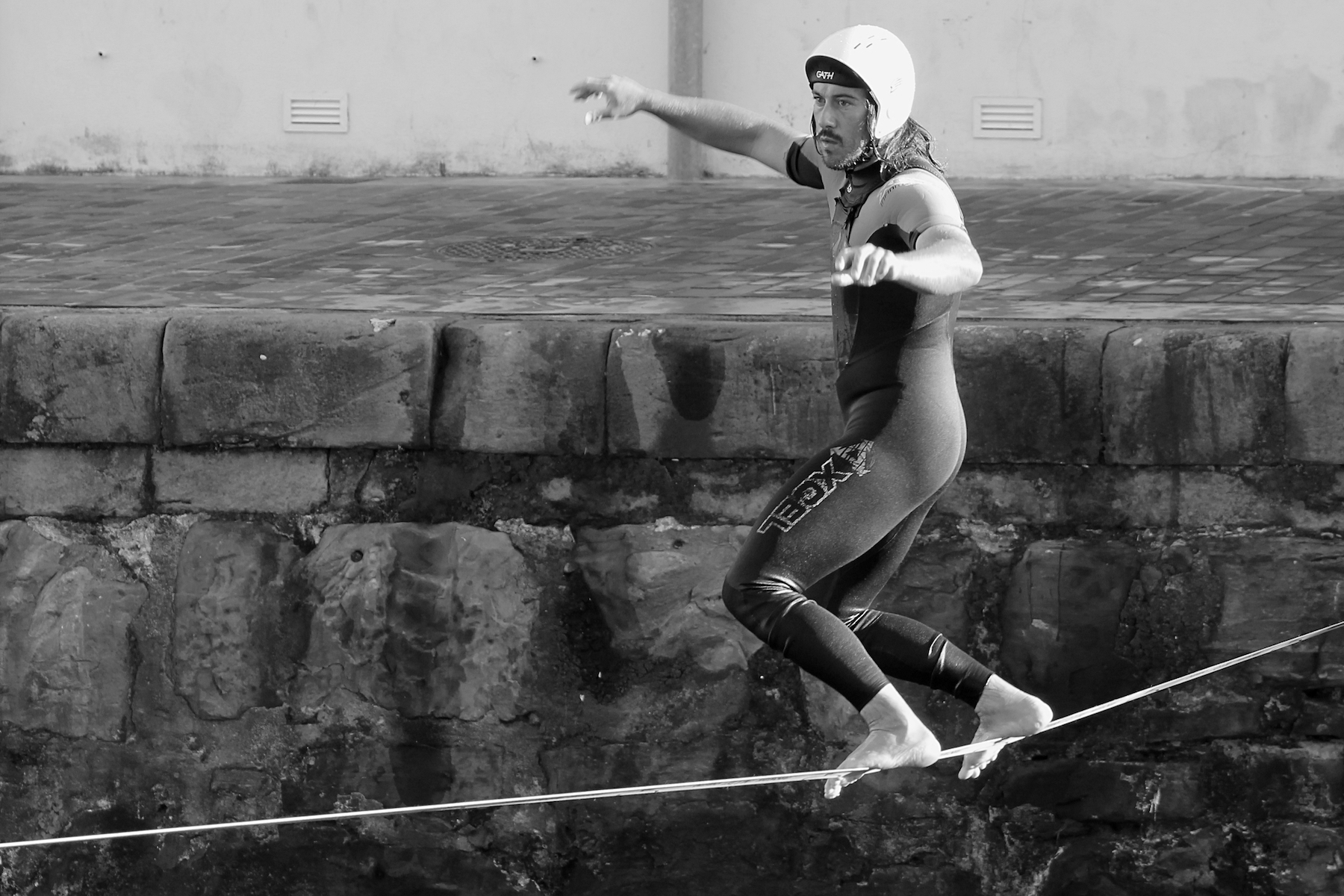What Work-Life Balance Actually Takes


A few weeks ago, my daughter and I ran into a woman named Lianne balancing on a slackline1 in the park. My daughter was fascinated (and wanted to try it herself)… so we ended up hanging out with her for a while.
As I watched, one of the things that struck me was just how movement it took to stay balanced. I’m not only talking about when she was walking either. Even when she was “standing still”, she had to constantly shift her weight and make adjustments.
Everything was dynamic.
This observation may not sound all that shocking.
Except, we rarely view balance this way in other areas of life. People usually talk about achieving “work-life balance” as if it’s some static thing. Just split your time evenly between work and the rest of life. Or, just reach some similar “magic ratio” and your life will be totally perfect… forever.
Maybe that’s the case for some people.
However, the problem (at least for me) is that life is messy and complicated. It’s chaotic. And different circumstances require different strategies. That’s especially true if you’re living life “up on the line”… where you’re playing a bigger game such as building a business, crafting a career, creating art, or being a parent.
You can find a “perfect” routine that works for a period of time…
But then your kid figures out she can climb up onto the kitchen counter and get into all that stuff that was supposedly “out of reach”. Or you take on a big, super exciting project that suddenly demands more of your time and energy. Or you get sick and your body forces you stop and rest.
Either way, your nice, orderly routine gets thrown out the window. And by the time you adjust to the new set of circumstances, life changes and you have to completely readjust all over again. As the Yiddish saying goes… “Mann Tracht, Un Gott Lacht."2
That’s why I find balancing on a slackline a more helpful analogy for work-life balance.
You won’t find some “perfect balance” that works for all time (or for all people). What it means to be balanced depends entirely on your situation… month to month, week to week, hour to hour, and minute to minute.
What’s more? Keeping balanced often means acting in ways that look totally unbalanced from the outside. Just take the guy in the picture above. His posture doesn’t look all that stable. Yet, as an athlete, he knows how to keep adjusting to stay on the line.
So, how do you practically find balance in your own life?
Well, I could list off a ton of tips. I could advise you to exercise more, go on a date with your significant other, pick up a new hobby, outsource work to a virtual assistant (or nanny), or take a nap. Those are all great things to do. However the best action depends entirely on the circumstances you’re dealing with… right now.
So before you get to the specifics, focus on the one foundational skill: awareness.
Being aware gives you real-time data to make decisions from. It gives you the knowledge for what adjustments to make and when to make them. And it keeps you from gradually falling out of alignment without you noticing.
This is not easy. There’s a lot to keep track of.
You have to have a pulse on your physical well-being. How are your energy levels? Are you getting the right food and nutrients? Are you moving your body? Are you getting enough sleep? Or said another way, how’s the “human animal” doing?
You have to read the health of your close relationships. Are you putting enough time into them? Is there a sense of warmth and affection? Are conflicts being resolved through calm conversation? Or do they often come out of nowhere and explode in your face? Are the needs of your loved ones being met (emotional, mental, etc.)?
You have to understand the demands of your business or work. Do you need to bring in new clients? Do you have creative work that demands more uninterrupted blocks of time? What requests are people making of you? What urgent tasks need dealing with? What activities are important and worth doing (even if they’re not urgent)? Are there new skills you need to learn? Do you have more on your plate than you can handle?
You have to manage trade-offs between the short term and the long term. For even beneficial things become harmful if you keep doing them for too long. Taking a week off work for vacation can give you needed rest and quality time with family. But always living life in “vacation mode” makes you neglect other important priorities… such as making money to cover your expenses.
You have to track your vision and values. Are you playing the game you want to be playing. Do you even understand what actually matters to you in the first place?
I could go on and on.
Again, you don’t just make this evaluation once and then move on. Every action involves sacrifices. Prioritizing balance in one way means compromising balance in another.
When Lianne was on the slackline, every tiny adjustment shifted her center of mass, where her momentum was taking her, or how the life felt beneath her feet. She had to be aware of those shifts (at least subconsciously) in real-time.
Thankfully, awareness is a skill you can learn, practice, and get better at.
At first, you’ll need to make it a more conscious process.
That could mean adding a formal practice like meditation or journaling… moments where you stop and notice what’s going on inside your head. Rituals like these ground you and set up your day.
It could mean asking for help from a friend and mentor… someone who will speak honestly about your situation.
Or, it may even take a need to do a detailed assessment of your life. Write out each area in a list (health, family, work, etc.) and evaluate them. Is there a feeling of life and energy? Are you working toward your desires/goals? Are there habits or systems you need to put in place? Or are you overly focused on that area at the expense of other parts of your life?
As your awareness grows over time, you can start to identify “warning flags” for yourself. These are small signals that tell you you’re out of alignment. For instance, if I notice a strong resistance to meditating… often I’m avoiding something uncomfortable. Or if I catch myself regularly working through suppertime with the family… then I’m probably not structuring my work time effectively (or have taken on too much).
Eventually, these practices of awareness will become automatic. You’ll internalize them. And, as a result, you’ll be able to maintain a baseline level of balance with less effort.
Of course, this does not mean that living a balanced life will get easier.
In fact, finding balance will actually become harder.
Why?
Because the more skill you have with balance… the more you’ll be able to push your edges and take on bigger, exciting challenges.
For example, Lianne shared how she could walk back and forth on the slackline consistently. But now she was trying to jump up and land balanced on the line again.
However, in the process of learning…
She was falling down. She was falling down a lot.
Yet, as she told me, being able (and willing) to fall right was one of the most important things about learning to do the slackline. Yes, falling is uncomfortable. Yes, it knocks you up a bit. But if you’re not willing to fall, you won’t take any risks on the line… and you won’t learn anything. And if you fall well, you won’t be injured and can just get back up and try again.
It’s a good reminder.
Because there will be many times you “fall off the line”. You will get way out of balance sometimes.
So expect it to happen.
And when it does… reset. Get back to “zen zero”. Make the adjustments you need to make – be it spending more time with family, getting extra rest, modifying your work routines, creating new systems and habits, clarifying your values, or whatever else is necessary.
Then get back up on the line and try again.
Image By Nicolas Vollmer